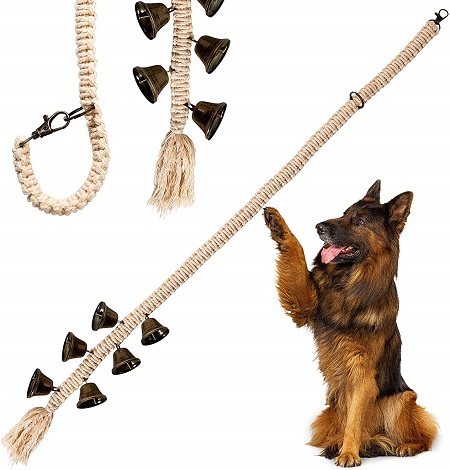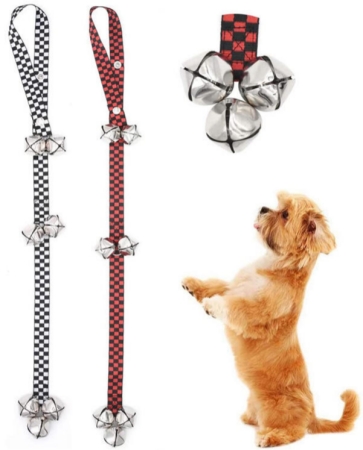
Best Doggie Doorbell:15+ Models Tested for Potty Training
Are you training your doggie doorbell manners, or does your furry friend incessantly scratch or bark at the door to go outside? You need a

Are you tired of your dog barking non-stop or scratching the door to signal their needs? That’s where the trusty dog doorbell comes into play. This ingenious device allows your furry friend to communicate without the noise, but it’s not immune to wear and tear.
In this guide, we’ll delve into the world of dog doorbells and explore strategies to extend their lifespan. From understanding the inner workings to managing common wear factors, let’s embark on a journey to make your dog doorbell last longer.
While a dog doorbell might appear simple, it’s a carefully engineered device with several key components. At its core, it includes a button or sensor that your pet can interact with to signal their needs.

This input triggers a transmitter, which sends a signal to a receiver inside your home. The receiver, often equipped with chimes or lights, alerts you to your pet’s request. Understanding this basic mechanism is crucial to maintaining your dog doorbell.
Identifying the everyday culprits that can lead to your dog doorbell wearing out prematurely.
One of the primary factors contributing to wear and tear on your dog doorbell is frequent usage. If your pet constantly uses the device to go in and out, the button or sensor can wear out over time. To extend its lifespan, consider training your pet to use the doorbell only when necessary.
Frequent usage of the dog doorbell is undoubtedly a sign that your pet appreciates the convenience it offers. However, the more your pet uses it, the quicker the components can wear out.
It’s essential to strike a balance between letting your pet communicate effectively and reducing unnecessary wear on the device. Training your pet to use the doorbell judiciously can help prolong its lifespan.
Your dog doorbell is exposed to the elements, which can impact its longevity. Extreme temperatures, whether hot or cold, can affect the device’s internal components.
For example, extreme heat may cause plastic parts to warp, while cold temperatures can make them brittle. Humidity can lead to moisture buildup, potentially causing corrosion.
To mitigate these effects, consider installing your dog doorbell in a sheltered area or using weather-resistant enclosures.
Your pet’s behavior can significantly influence the wear and tear of the dog doorbell.
If your furry friend tends to be overly enthusiastic when using the device, they may inadvertently apply more pressure or force than necessary, leading to premature wear of the button or sensor. Training your pet to use gentle and deliberate touches can help extend the device’s lifespan.
Explore practical tips and strategies to keep your dog doorbell in prime condition.
Regular maintenance is essential for the optimal performance and longevity of your dog doorbell. Establish a routine that includes inspecting the device for any visible wear or damage. Clean the button or sensor periodically to remove dirt and grime that can affect its functionality. Additionally, check the batteries and connections to ensure they are in good condition.
To reduce the impact of frequent usage on your dog doorbell, consider incorporating alternative communication methods with your pet.
This can include training them to use verbal cues or teaching them to signal less frequently. By balancing the use of the doorbell with other communication methods, you can help prolong its lifespan.

Managing environmental factors is crucial to preserving your dog doorbell. Ensure it is installed in a location that shields it from extreme temperatures, direct sunlight, and heavy rain.
If your pet frequently uses the doorbell in rainy conditions, consider using a weatherproof enclosure to protect it from moisture damage. These proactive measures can go a long way in extending the device’s lifespan.
To safeguard your dog doorbell’s longevity, consider purchasing a device with high-quality components and durable materials. This initial investment can pay off in the long run. Additionally, using protective covers or shields can help shield the device from potential damage.
Uncover key actions and choices that will help ensure your dog’s doorbell remains a reliable communication tool.
Learn why choosing high-quality dog doorbell components is crucial for durability.
Explore the significance of proper installation techniques for maximizing your dog doorbell’s lifespan.
Training your pet to use the dog doorbell correctly is essential for its durability. Teach your pet to signal only when they genuinely need to go outside or come in.

Discourage unnecessary use, which can accelerate wear. Positive reinforcement and consistent training can help form good habits that benefit both your pet and the longevity of the device.
Regularly assessing your dog’s doorbell condition is a proactive way to catch and address potential issues before they become major problems. Conduct periodic checks to ensure all components are functioning correctly.
Inspect the button or sensor for signs of wear, and replace batteries as needed. By staying vigilant and addressing issues promptly, you can ensure your dog’s doorbell stands the test of time.
In conclusion, your dog doorbell is a valuable tool for communication between you and your pet.
By understanding how it works and taking proactive measures to reduce wear and tear, manage environmental factors, and invest in quality components, you can significantly extend its lifespan.
Regular maintenance, proper installation, and positive pet training are key elements in ensuring that your dog doorbell continues to serve you both faithfully for years to come.
Implement these techniques and enjoy the extended life of this essential pet accessory.
Q1: Can I use my dog doorbell in extreme weather conditions?
Answer: While dog doorbells are designed to withstand some exposure to the elements, extreme weather conditions like intense heat or freezing cold can impact their performance and longevity. It’s advisable to install your dog doorbell in a sheltered area or consider using weatherproof enclosures to protect it from extreme weather.
Q2: How often should I replace the batteries in my dog doorbell?
Answer: Battery replacement frequency depends on usage. Typically, batteries can last several months to a year. It’s a good practice to check the batteries regularly and replace them as needed to ensure uninterrupted functionality.
Q3: What should I do if my pet becomes too enthusiastic with the dog doorbell?
Answer: If your pet tends to use the dog doorbell excessively and with too much force, it may lead to premature wear. Consider retraining your pet to use the doorbell judiciously. Positive reinforcement and consistent training can help form good habits, reducing wear and tear.
Q4: Can I install the dog doorbell myself, or should I hire a professional?
Answer: While many dog doorbells can be installed by pet owners, proper installation is crucial for longevity. If you’re unsure about the installation process, it’s advisable to consult a professional. A well-installed dog doorbell is less likely to suffer from wear and tear due to improper placement.
Q5: How can I prevent my dog from using the doorbell unnecessarily?
Answer: Training your pet to use the doorbell only when they genuinely need to go outside or come in can help prevent unnecessary wear. Reward your pet for using the doorbell appropriately and discourage excessive or frivolous use. Balancing the use of the doorbell with other communication methods can also be effective in reducing unnecessary signaling.


Are you training your doggie doorbell manners, or does your furry friend incessantly scratch or bark at the door to go outside? You need a

When it comes to dog pee, much like humans, the urine of animals is a vital health indicator. Just as human urine reveals a lot

Noticed your dog yawn more often than usual? While it’s adorable, it could also be a sign of something to consider if it appears excessive.

Wondering what’s so fantastic about bell train a dog? Picture a world where your furry friend always alerts you when they need to go outside,

Are you training your doggie doorbell manners, or does your furry friend incessantly scratch or bark at the door to go outside? You need a

When it comes to dog pee, much like humans, the urine of animals is a vital health indicator. Just as human urine reveals a lot

Noticed your dog yawn more often than usual? While it’s adorable, it could also be a sign of something to consider if it appears excessive.

Wondering what’s so fantastic about bell train a dog? Picture a world where your furry friend always alerts you when they need to go outside,
Copyright © 2024 doggydogdoorbell. All Rights Reserved.